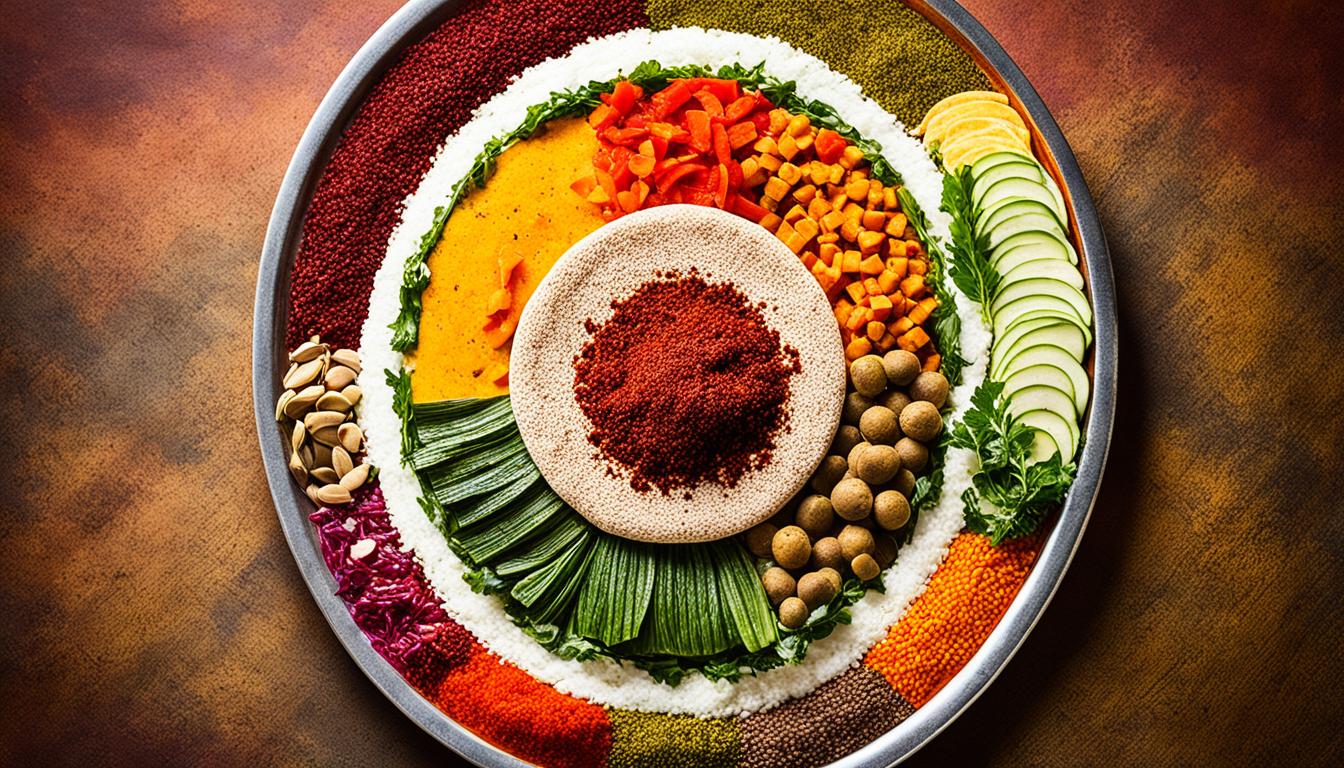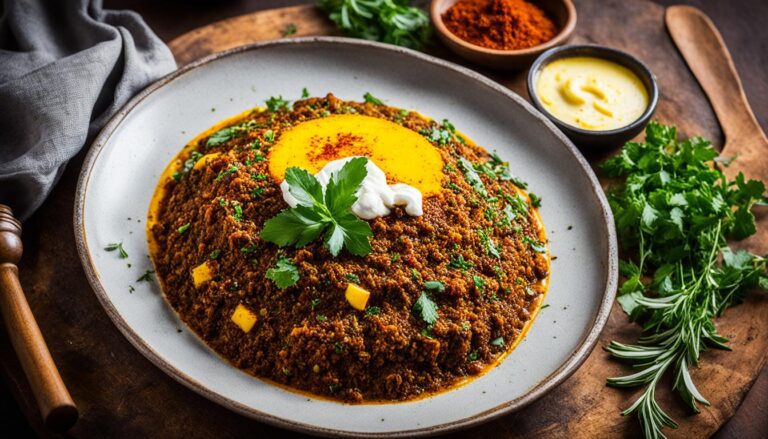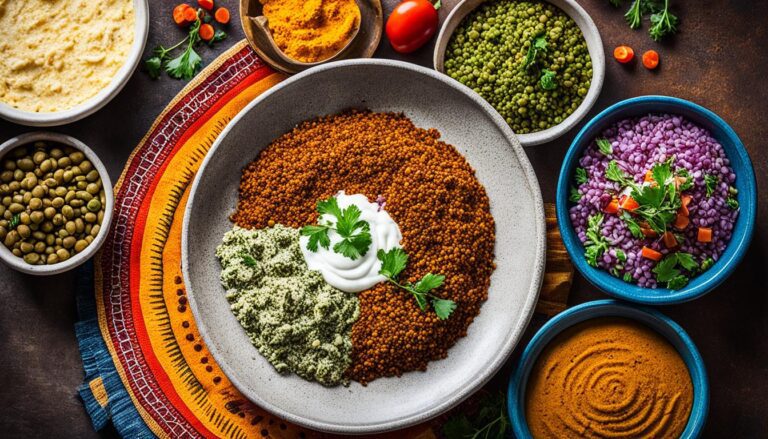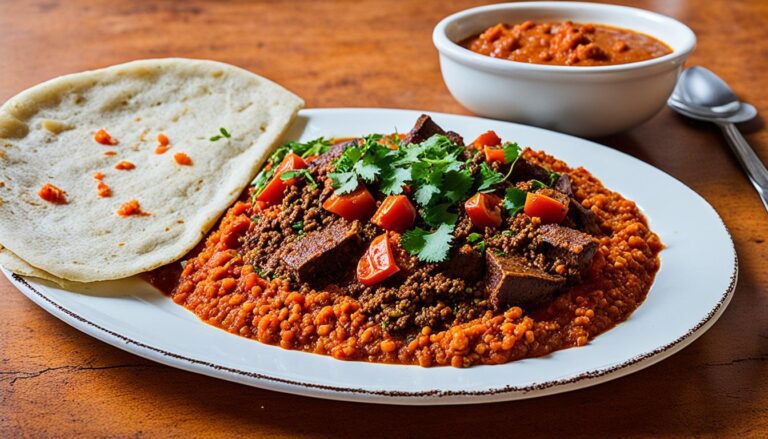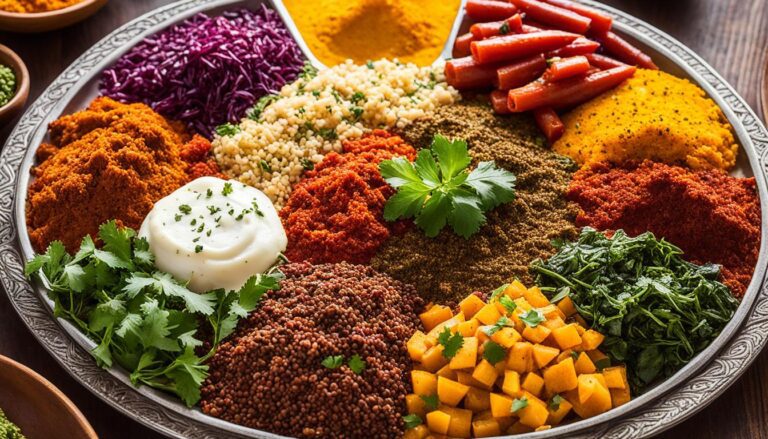What Is Hamley Ethiopian Food?
When it comes to exploring new cuisines, Ethiopian food offers a culinary adventure like no other. From its flavorful stews to its unique sourdough flatbread, Ethiopian cuisine has captivated food enthusiasts around the world. But what exactly is Hamley Ethiopian Food, and what makes it a cherished part of Ethiopian culinary tradition? Join us as we delve into the rich heritage and tantalizing flavors of this vibrant cuisine.
Key Takeaways:
- Hamley Ethiopian Food is a beloved part of Ethiopian cuisine, known for its unique flavors and communal dining experience.
- The cuisine centers around injera, a sourdough flatbread made from teff flour, which serves as a base for various stews and spices.
- Ethiopian food is rich in spices and seasonings, with berbere and mitmita being popular blends.
- Vegetarian and vegan options are plentiful in Ethiopian cuisine, with fasting days offering a wide array of plant-based dishes.
- Don’t miss out on traditional Ethiopian dishes like doro wat, shiro wat, and injera fit fit.
The Importance of Injera in Ethiopian Cuisine
Injera is the foundation of Ethiopian cuisine and is central to every Ethiopian meal. Made from teff flour, injera is a soft and spongy flatbread that serves as a base for other dishes. It is used to pick up bites of stews and curries, creating a unique and flavorful combination of flavors and textures. Injera is a sourdough bread that is slightly fermented, giving it a tangy taste. It is often served on a communal platter called a gebeta, along with various dishes.
Injera plays a crucial role in Ethiopian cuisine, not only as a staple food but also as a cultural symbol. The process of making injera involves fermenting teff flour, a grain native to Ethiopia, which gives the bread its signature sour taste and airy texture. The fermentation process enhances the nutritional benefits of teff flour, making injera a nutritious and healthy choice.
The unique texture and taste of injera make it perfect for soaking up the rich flavors of Ethiopian stews and curries. The soft and porous nature of the bread allows it to absorb the savory juices, creating a harmonious blend of flavors in every bite. Injera’s tangy and slightly sour taste complements the spiciness of Ethiopian dishes, adding depth and complexity to the overall dining experience.
Moreover, injera plays a significant role in Ethiopian dining etiquette. Traditionally, Ethiopian meals are served on a communal platter called a gebeta, where various dishes are arranged around a large piece of injera. Diners tear off pieces of injera and use them to scoop up the stews, meats, and vegetables, creating a convivial and interactive dining experience. Sharing food from the same platter is seen as a gesture of hospitality and unity, strengthening bonds among family and friends.
Overall, injera is more than just a bread; it is a crucial element that ties together the flavors, traditions, and communal spirit of Ethiopian cuisine. So, the next time you savor the rich and aromatic dishes of Ethiopian food, remember to indulge in the delightful combination of flavors by pairing them with injera.
Spices and Seasonings in Ethiopian Food
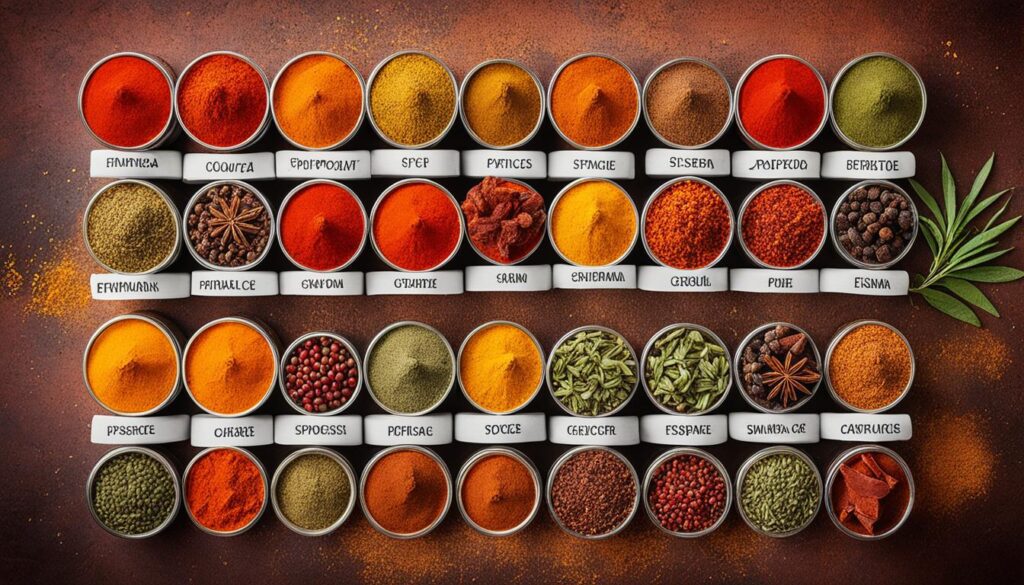
Ethiopian food is renowned for its vibrant and robust flavors, thanks to the rich assortment of spices and seasonings used in its dishes. The combination of these aromatic ingredients creates a culinary experience that is truly unique to Ethiopian cuisine.
At the heart of Ethiopian spice blends is Berbere, a versatile combination of chili powder, ginger, garlic, cardamom, and cinnamon. This aromatic blend adds a fiery kick and depth of flavor to a wide range of Ethiopian dishes. From savory stews to marinated meats, Berbere is a staple ingredient that infuses every bite with a distinct Ethiopian flair.
Another popular Ethiopian spice blend is Mitmita. Known for its spicy and savory profile, Mitmita is often used as a side seasoning for meat dishes. Its unique blend of flavors, including chili peppers and various herbs, adds a tantalizing heat and complexity to any dish it accompanies.
In addition to spice blends, Ethiopian cuisine also incorporates Niter kibbeh, a key ingredient that brings richness and flavor to many dishes. Niter kibbeh is an Ethiopian clarified butter that is infused with a mixture of spices such as garlic, ginger, and other aromatic herbs. Its distinctly savory and buttery taste elevates the flavors of Ethiopian stews, stir-fries, and sautéed vegetables.
These aromatic spices and seasonings, including Berbere, Mitmita, and Niter kibbeh, are integral to the authentic taste of Ethiopian cuisine. They create a symphony of flavors that is sure to tantalize the taste buds and transport you to the vibrant culinary landscape of Ethiopia.
Vegetarian and Vegan Options in Ethiopian Cuisine
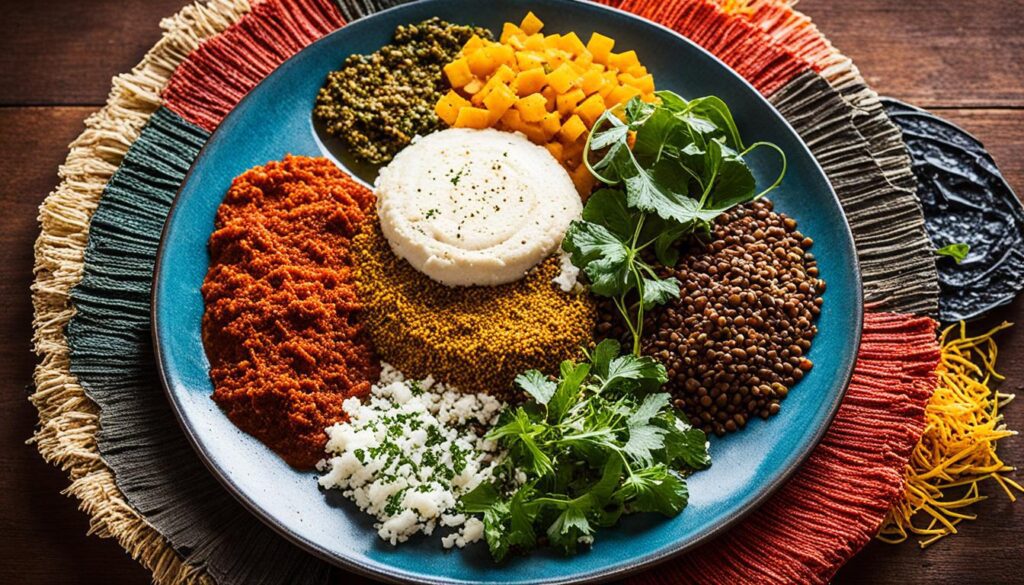
Ethiopia offers a rich tradition of vegetarian and vegan food, making it a paradise for plant-based eaters. Whether you’re following a vegetarian or vegan diet, you’ll find plenty of options to satisfy your taste buds. In fact, Ethiopia has specific fasting days, such as Wednesdays and Fridays, as well as during the lent period, where vegetarian and vegan food takes center stage.
One popular vegetarian dish is shiro wat, a flavorful stew made from chickpeas and broad beans. This hearty and protein-rich dish is often served with injera, the traditional Ethiopian flatbread. Another delicious vegetarian option is misir wat, a spiced red lentil stew that is both filling and nutritious.
For those following a vegan diet, many restaurants in Ethiopia offer vegan versions of traditional meat dishes. These plant-based alternatives often use innovative substitutes to recreate the bold flavors and textures of the original recipes. As a vegan, you can enjoy the rich and aromatic flavors of Ethiopian cuisine without compromising on your dietary preferences.
So, whether you’re vegetarian or vegan, Ethiopia has a diverse range of options for you to explore and indulge in. From stews and curries to flavorful spices and grains, Ethiopian cuisine provides a culinary experience that caters to all dietary choices.
Traditional Ethiopian Dishes to Try
Ethiopian cuisine offers a wide variety of delicious dishes to try. Indulge in the flavorful and aromatic experiences of traditional Ethiopian cuisine with these must-try dishes:
Doro wat
Doro wat is a tantalizing chicken stew that should not be missed. Prepared with tender chicken simmered in a blend of berbere spices, this dish is bursting with rich flavors. Served with injera, the sourdough flatbread, doro wat is a true delight for the taste buds.
Key wat
Key wat is a slow-cooked beef stew that embodies the heartiness of Ethiopian cuisine. The meat is marinated with aromatic spices and simmered until tender. Served alongside injera, key wat is a satisfying and comforting dish.
Shiro wat
For those seeking vegetarian options, shiro wat is a delectable choice. Made from a blend of chickpea and broad bean flour, this hearty stew showcases the versatility of Ethiopian cuisine. The flavors of the spices and legumes come together harmoniously, creating a savory and filling dish.
Ethiopian tomato salad
Complement your meal with the refreshing and vibrant flavors of Ethiopian tomato salad, also known as salata. This simple yet flavorful salad consists of ripe tomatoes tossed with onions, jalapenos, and Ethiopian spices. The combination of tangy and spicy flavors provides a perfect balance to the rich and robust main dishes.
Delve into the magnificent world of Ethiopian cuisine by experiencing these traditional dishes. From the aromatic spices of doro wat and key wat to the satisfying vegetarian option of shiro wat, each bite is an invitation to explore the rich flavors and cultural heritage of Ethiopia. Pair your meal with a refreshing Ethiopian tomato salad, and let the culinary journey transport you to the vibrant streets of this beautiful country.
Breakfast and Snack Options in Ethiopian Cuisine
Ethiopian cuisine offers a range of delicious breakfast and snack choices to start your day or enjoy as a midday treat. Whether you’re looking for something savory or sweet, there are options that will satisfy your cravings and introduce you to the flavors of Ethiopian breakfast.
One popular breakfast dish is Chechebsa, made from kita bread. Kita bread is a flaky and crisp flatbread that is fried until golden brown. It is served with a drizzle of honey and a dollop of creamy, tangy plain yogurt. The combination of the crunchy bread and the sweetness of honey creates a delightful flavor contrast that will leave you wanting more.
Another breakfast favorite is Injera fit fit, also known as fir fir. This dish is made using leftover injera, the sourdough flatbread that is a staple in Ethiopian cuisine. The leftover injera is torn into bite-sized pieces and mixed with a flavorful stew, resulting in a moist and juicy combination of flavors. Injera fit fit is typically enjoyed in the morning and is a hearty and satisfying way to start the day.
These breakfast dishes can also be enjoyed as a light snack throughout the day. Whether you’re looking for a quick bite or a filling meal, Chechebsa and Injera fit fit are versatile options that showcase the unique flavors of Ethiopian cuisine.
The Variety of Ethiopian Spices and Seasonings
Ethiopian cuisine is renowned for its diverse range of spices and seasonings, which add depth and complexity to the flavors of the dishes. One of the standout spices in Ethiopian cooking is Berbere. Made from a blend of chili peppers, garlic, ginger, basil, and other aromatic ingredients, Berbere infuses Ethiopian dishes with a rich and fiery flavor.
Another popular spice is Mitmita, a powdered seasoning mix that adds a spicy kick to the food. With its bold and invigorating taste, Mitmita is often used to enhance the flavor of grilled meats, stews, and sautéed vegetables.
One of the most versatile ingredients in Ethiopian cuisine is Awaze. This paste is made from Berbere spices, oil, and either Ethiopian wine or whiskey. Awaze serves as a delicious dip for injera or can be used as a flavorful stir-fry sauce to elevate the taste of vegetables, meat, or tofu.
Conclusion
Ethiopian food is a culinary experience that combines the rich flavors of traditional dishes, the joy of communal dining, and the beauty of cultural traditions. The use of injera, a sourdough flatbread made from teff flour, as a staple adds a unique element to every meal. Whether you’re a meat lover exploring options like doro wat and key wat, or a vegetarian enjoying dishes like shiro wat and misir wat, Ethiopian cuisine offers a diverse range of choices for everyone.
But it’s not just about the food itself, Ethiopian dining is an experience in itself. The communal dining style allows for shared plates and the opportunity to feed each other, creating an intimate and social atmosphere. It’s a chance to connect with loved ones, bond over delicious flavors, and create lasting memories.
So, when you delve into the world of Ethiopian food, be prepared to embark on a culinary journey that goes beyond satisfying your hunger. Embrace the richness of flavors, the warmth of cultural traditions, and the joy of sharing a meal with others. Whether you’re a food lover or a culture enthusiast, Ethiopian cuisine promises a remarkable culinary experience that will leave you wanting more.

